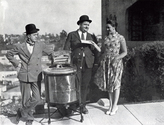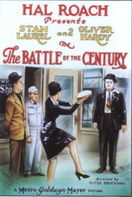As seems appropriate for a movie that derives most of its comedy from offensive odors, With Love and Hisses mostly stinks. As L&H’s Flying Elephants is largely derivative of Charlie Chaplin’s His Prehistoric Past, With Love and Hisses tries to milk the last drops of comedy from territory already covered in Chaplin’s Shoulder Arms.
There are small traces of great L&H comedy to come, as when Hardy’s brute of a sergeant lords it over Laurel at the beginning, but they’re quickly abandoned as the movie settles into the trite kind of filler that Laurel & Hardy would eventually transcend. Laurel’s mincing routine during military formation is only a faint echo of funnier military mess-ups in L&H’s Pack Up Your Troubles and The Flying Deuces.
The movie’s most-quoted gag is when Hardy’s troops, having taken a skinny-dip at a nearby pond and then being left without their uniforms, stick their heads through a movie billboard of The Volga Boatmen and walk back to camp “dressed” this way. But even that decent-enough gag is protracted via a run-in with some hornets.
The movie’s opening title tells us that “There were cheers and kisses as the Home Guards left for camp — the married men did the cheering.” By the time With Love and Hisses is over, it’s mostly the audience who is cheering the movie’s end.









